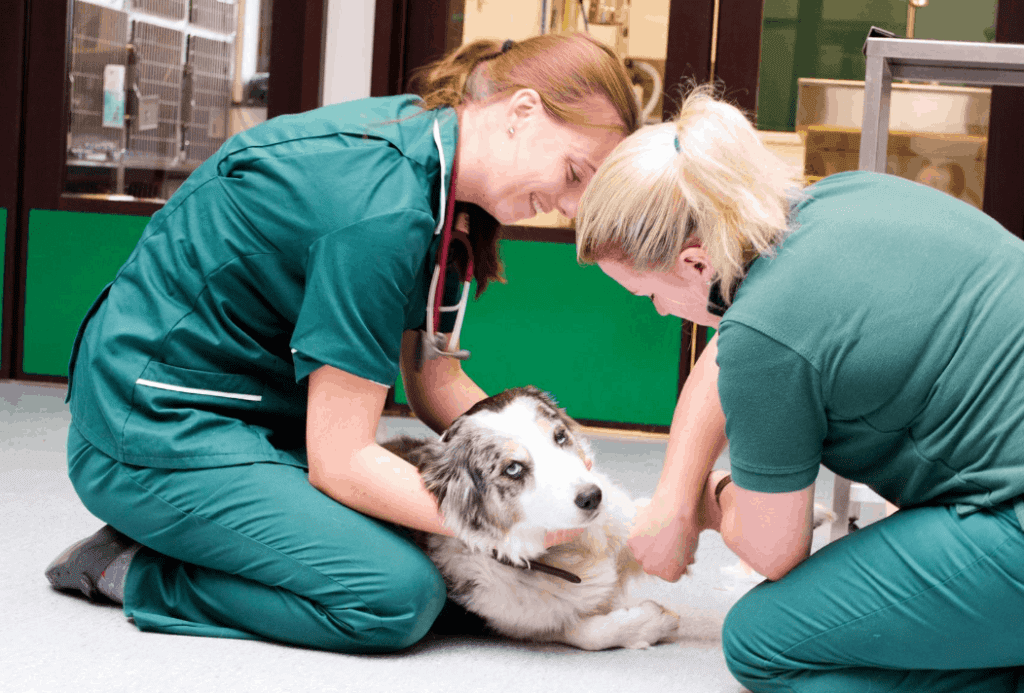Why Won’t My Dog Eat?
Dogs usually love to eat and feeding time is typically most dogs’ favorite time of day. So it can be very frustrating and unnerving if your dog all of a sudden does not seem interested in food or is eating much less than is normal for them.
There are many reasons why your dog may be refusing to eat. Some of these can be resolved at home. However, there are also serious medical conditions that can cause your dog to not want to eat and you will need to take your dog to their veterinarian to evaluate for these diseases. In this article, we will discuss the benign and also the serious reasons why your dog may not want to eat, things you can do at home to entice eating, and when you should take your dog to the veterinarian!
Benign reasons why your dog may not want to eat
Dogs are notorious for sniffing around and tasting things, whether that is outside, inside, in the trash can, or licking some bacon grease off of a pan on the stove.
It is common for dogs to ingest something, oftentimes without our knowledge, that doesn’t agree with their stomachs. In these situations, they may not want to eat because their stomach feels queasy. They may or may not vomit and have some diarrhea as well.

Source: Giphy
If you like to feed your dog table scraps, or your dog gets used to getting table food from you at certain times of the day, your dog may soon learn that if they just hold out and don’t eat their dog food, you will give them the food they really want. Dogs are definitely quick learners and will sometimes try to outsmart us by not eating their food in order to get you to give them some of your food.
Occasionally, when the weather gets colder and some dogs are less active than usual, they may not want to eat as much as they typically do, as their energy requirements are decreased. Additionally, a non-spayed female dog who is actively in a heat cycle may not have much of an appetite, and this is completely normal.

Source: Giphy
Things you can try at home to entice your dog to eat
If your dog isn’t eating but otherwise acting completely normal, or only had one episode of vomiting or diarrhea, and has been fine since, there are some things you can try to entice your dog to eat.
Take a break for 24 hours
First of all, it’s fine to allow your dog’s intestines to take a break, and not feed them for 12-24 hours, to give things time to settle down. However, make sure to keep water available to them so they do not become dehydrated. It is very important to note that if your dog isn’t eating or drinking you must take them to the vet immediately.
Try Bland foods
After 24 hours, you can offer your dog some boiled/cooked boneless, skinless chicken breast with a little bit of cooked rice and/or pasta. It is best to offer this bland, easily digestible food in very small portions every 2-4 hours throughout the day. Small portions are easier on the stomach, and frequent feedings can help encourage intestinal motility and help get the gut back to normal functioning.
Mix bland foods with your dog’s normal diet
Once your dog is starting to eat this for one day, you can then start mixing in this bland diet with your dog’s normal food and slowly transition them back to their regular food over the course of one week. You can do this by gradually decreasing the amount of chicken and rice, and increasing the amount of dog food in their bowl each day.
Offer your dog different food with a different texture
Something else you can do to try to entice them to eat is to offer them a different texture of food than they are used to. For instance, if your dog typically eats dry kibble, buy them some canned or wet dog food and offer this to them. It is best to stick with the same brand of food they are used to, but see if you can find it in a canned version instead of dry.
Call your vet for suggestions
It is also always a good habit to call your veterinarian’s office if you have any concerns about your dog, as they may have more individually-directed suggestions you can try at home for your particular dog.
When you should worry about your dog not eating
If the above suggestions don’t work, if your dog has refused food for more than 24-48 hours, or if your dog is having protracted vomiting and/or diarrhea in addition to not eating, it is time to schedule an appointment with your dog’s veterinarian.
Sometimes, even if the decreased appetite is due to a benign cause, dogs may need prescription anti-nausea medication to help them feel good enough to want to eat again. Additionally, if you have been noticing gradual weight loss with your dog and they begin to refuse food, it is best to go ahead and take them to the veterinarian instead of waiting it out at home.
Diseases or conditions that may decrease your dog’s appetite
There are many underlying causes, that may result in your dog not wanting to eat, that need to be addressed by a veterinarian. They can range from mouth pain or nausea, to kidney disease or hypothyroidism.
Here is a list of some of the most common diseases or conditions that may cause your dog’s appetite to be off:
- Dental Disease; Broken Tooth
- Hypothyroidism (too little thyroid hormone production)
- Uncontrolled Nausea
- Uncontrolled Pain (such as back pain)
- Parvovirus & Other Infections
- Kidney Disease
- Liver Disease
- Cancer (various forms)
- Diabetic Ketoacidosis (severe form of unregulated/undiagnosed Diabetes)
- Inflammatory Bowel Disease
- Autoimmune Diseases, such as Immune Mediated Hemolytic Anemia
Some of these conditions, such as a tooth problem, can be identified on a physical exam alone, and then a treatment plan can be developed to help with any pain or discomfort causing a decrease in your pet’s appetite.

Other conditions on this list, such as Hypothyroidism, will need to be diagnosed by allowing your veterinarian to perform blood work on your dog. Oftentimes, the blood sample needs to be sent to an outside laboratory for testing, so it may take 1-2 days for your veterinarian to be able to contact you with results of the testing. Sometimes additional testing will be needed to confirm results, but usually your veterinarian can just call the laboratory to have the additional blood tests added on (it may be an additional expense for you, but these add-on tests are necessary to ensure the proper diagnosis is confirmed to be able to put your dog on the correct treatment protocol).
Finally, some of the disease conditions listed may require more extensive diagnostics and patience in order to get to the bottom of the problem. For instance, inflammatory bowel disease and certain types of cancers may require blood work, x-rays, and abdominal ultrasounds to be performed.
Work with your veterinarian to help your dog feel better
Working with your veterinarian is the best way to help your pet’s appetite and for them to feel better.
Working together, you can begin finding a solution, whether that is getting to the bottom of a serious medical condition, or better controlling their pain and providing them with good hospice care.
The post Why Won’t My Dog Eat? appeared first on VetBabble.




Post a Comment